Irene Choi
Korea’s cultural contact with Europe in the eighteenth century was largely mediated through its two East Asian neighbors, Japan and China. During the reigns of Qing emperors Kangxi (r. 1654-1722), Yongzheng (r. 1723-1735), and Qianlong (r. 1736-1795), Korean artists, scholars, and envoys were part of the same environment in Beijing as European missionaries and painters in residence at the Imperial Palace, most notably the Italian Jesuit Giuseppe Castiglione (1688-1766). In this article, I aim to position late Chosŏn Korea within larger artistic and cultural networks of the period. This will be done through the study of a particular type of Korean painting called Ch’aekkŏri, a still-life genre featuring books and other objects, usually on a folding screen, that flourished during the eighteenth century. I will focus first on aspects of the visuality and materiality of Ch’aekkŏri that engage questions around surface and depth, disorder and order, and pleasure and moderation of desire embedded in the medium of painting. Such issues can be situated within the broader socio-economical context of the late Chosŏn dynasty (1392-1910), when eighteenth-century Korean artists and travellers were actively involved in artistic exchanges with both China and the “West.” These exchanges are exemplified by the writings of a Chosŏn envoy, Lee Ki-ji (李器之, 1690-1722), which I will examine. Lee’s writings on Castiglione and on Jesuit paintings that highlight the material quality of painted “objects” serve as an important background to the production and reception of Ch’aekkŏri.
Scholarship on Ch’aekkŏri has previously noted the use of “Western” painting techniques in these screens, including the use of perspective, the rendering of illusionistic surfaces, and objects depicted in a three-dimensional manner. In the recent “global turn” in art history, Ch’aekkŏri have received unprecedented attention by scholars tracking the artistic exchanges between Korea and Europe in the early modern period.[1] However, the motif of the transposed, painted curtain in several Ch’aekkŏri that I analyze in this article and its relevance in “Western” discourse on the art of painting—especially that of the trompe-l’oeil technique—has curiously eluded art historical attention. This study proposes a new way of considering Ch’aekkŏri paintings beyond already familiar models of transmission, influence, and cross-cultural interaction. Through a comparative study of other relevant media concerning objects and things, such as contemporary Qing Chinese duobaoge多宝格 (“ten-thousand-treasure shelf”) and copper plaques from the Guangzhou workshop featuring objects displayed in a manner similar to Ch’aekkŏri, I ultimately aim to position this still-life genre, and late Chosŏn Korea more generally, within larger artistic networks and comparable productions of the long eighteenth century.
Materiality and Morality of Ch’aekkŏri
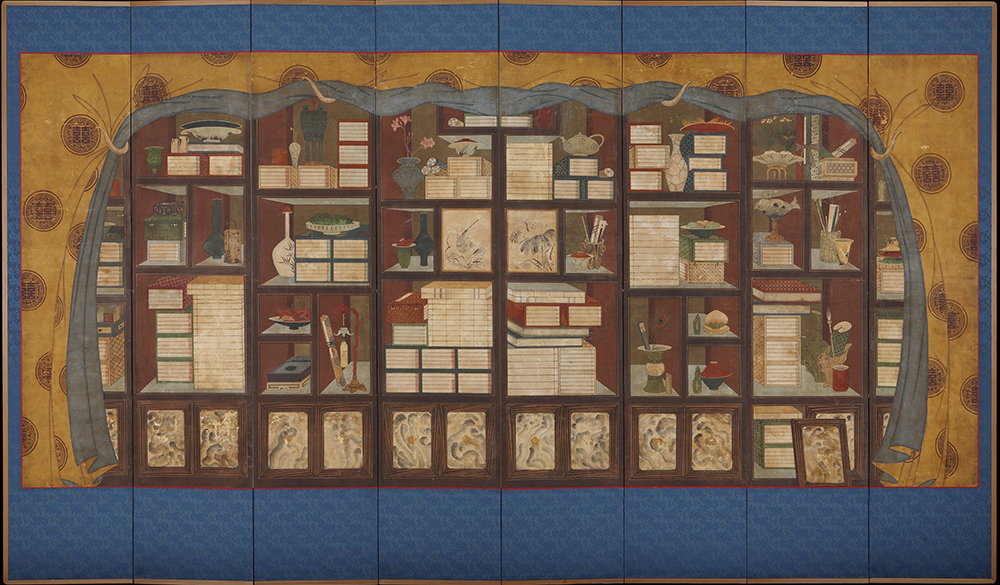
In an eighteenth-century Korean still-life painted by the court artist Jang Hanjong (張漢宗, 1768-1815), a curtain frames a bookshelf that displays a collection of objects across the eight-panel folding screen (Fig. 1). The silk curtain with the double-xi (囍) motif that signifies happiness appears to be rolled up and securely fastened with four ivory hooks. The opening in the curtain reveals the Wunderkammer-like ensemble of objects behind it. These range from everyday items like fruit bowls to luxury goods from China like the glazed porcelain vase with cracked-ice patterns that was in fashion during the Ming (1368-1644) and Qing (1644-1911) periods. Other items include an ink stone, a scholar’s rock, and, most importantly, neatly aligned stacks of books.[2] At the center of the cabinet, Jang includes two ink paintings—one with a lotus flower and the other with a shrimp, referring to the artist’s specialties as a renowned painter of animals and plants—to create a painting within a painting.[3] Apart from the partially folded curtain, the open door at the bottom of the shelf that reveals the books stored inside adds to the “naturalness” of the overall trompe-l’oeil effect. When folded, Jang’s screen would provide even more heightened illusionism with shadows cast by the folded panels reinforcing the niches of the bookshelf while adding three-dimensional volume to the painted curtain.
Jang’s curtain plays a dual role of covering up the opulent material goods considered superfluous for true Confucian self-cultivation and of flaunting such a tasteful and luxurious collection. The function of the curtain to both reveal and conceal the beautiful objects behind it is replicated by the irony inherent in the format of the folding screen. The Ch’aekkŏri delivers both a sense of coyness about conspicuous consumption and a sense of lust for material wealth that can only be fully realized when the folding screen is either on full display or in use to hide something. The premise of the self-conscious dynamics of revealing and concealing at work in Jang’s curtain is that the screen must somehow be “seen.” Here, reflexivity works as the representation acknowledges and manipulates the medium that gives it material form. This aspect is emphasized by the inclusion of the illusionistic curtain, a visual rhetoric familiar in the European painting tradition as a “self-definition of the painting,”[4] as defined by Victor Stoichita in his discussion of seventeenth-century Dutch art. In Jang’s case, he incorporated “both Western and East Asian perspective into one style of screen,”[5] showing multiple surfaces of an interior space in the Western style and using multiple vanishing points and isometric perspective to depict book stacks in the East Asian tradition.[6]
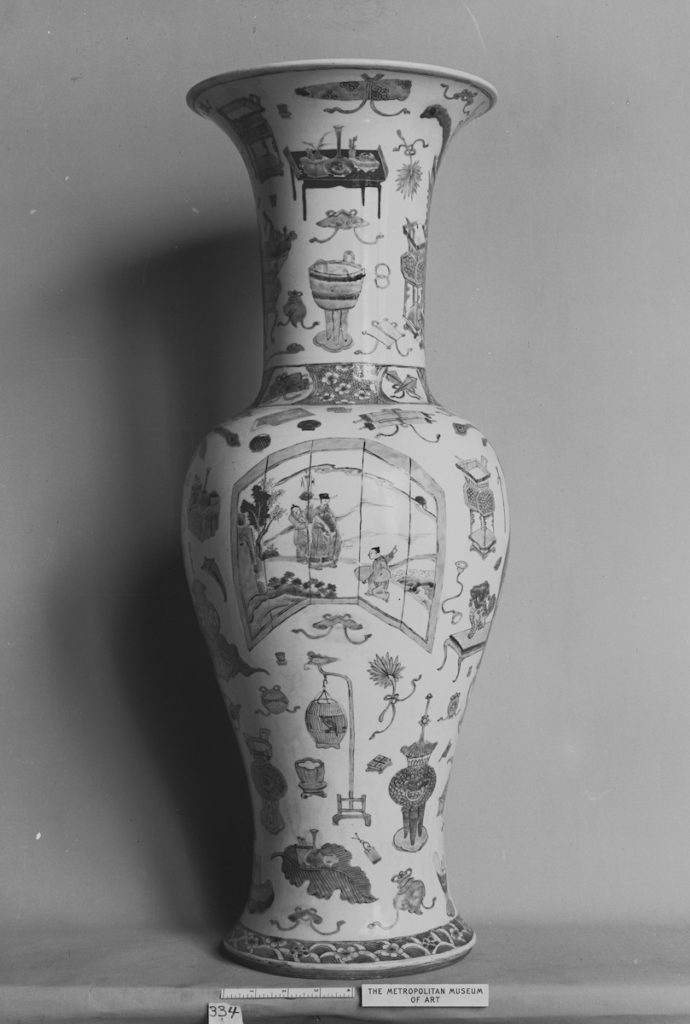
As paintings of objects, Ch’aekkŏri have been analyzed in conjunction with other forms and genres that are relevant to the still-life tradition. The display of material goods and the idea of collecting shown in Ch’aekkŏri have been linked to European cabinets of curiosity, quattrocento Italian studiolos, and Chinese duobaoge in the work of art historians Sunglim Kim, Joy Kenseth, and Jerome Silbergeld.[7] Ch’aekkŏri as portrayals of material objects and as reflections on the art of collecting and assemblage is also deeply related to contemporary Ming and Qing visual and material culture, ranging from Ming connoisseurship of antiquities expressed in the bogutu 博古圖 genre (“Wide range of Antiquities” or “Illustrated Catalogues of Antiquities”) to Ming-Qing painting and calligraphy manuals, encyclopedias, birthday screens or porcelains decorated with the “hundred antiques” theme (Fig. 2).[8] Literary pieces, such as Dream of the Red Chamber (also called The Story of the Stone, Hongloumeng, 紅樓夢, mid-eighteenth century) and The Plum in the Golden Vase (Jinpingmei, 金瓶梅, 1610), are also filled with verses about lavish objects on display and “depictive surfaces” that offer ekphrastic descriptions of private interiors.[9] From the sixteenth century onwards, Korean elites and collectors (scholars, and later the wealthy merchant and middle class) expressed passionate interest in Ming-Qing Chinese treatises on material things, such as the Treatise on Superfluous Things (Zhangwuzhi, 長物志, 1620-1627) by Wen Zhengheng (1585–1645), as well as in curiosity objects from Europe.
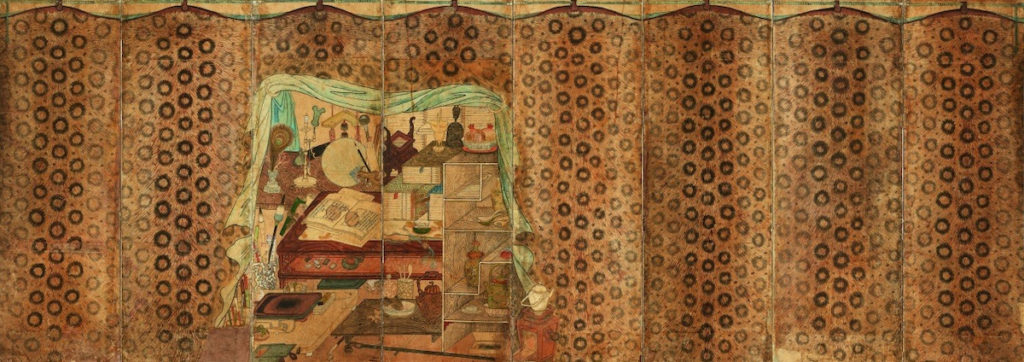
These interests were criticized by the Chosŏn King Chŏngjo (r. 1776-1800), who expressed concern about people’s unchecked consumption of books and things. In an early nineteenth-century Ch’aekkŏri painting entitled Ch’aekkŏri behind a Leopard-Skin Curtain (Fig. 3), an eight-panel folding screen by an anonymous artist, we find a display of still-life items similar to those featured in Jang’s painting (Fig. 1). But here a pair of glasses—undoubtedly Western imports—has been added to the center, as if the sitter reading a book has just left the studio. The shelf that framed the whole composition in Jang’s work is here transformed into a piece of smaller furniture in the corner, and scholar’s accoutrements are scattered rather chaotically and independently on the table, the floor, and in the cabinet. What immediately captivates the viewer in this work is the sumptuous leopard-skin curtain painted across the eight-panel folding screen. Out of the eight panels, six full panels are exclusively devoted to the leopard skin, which was an extremely expensive luxury item only given by the Chosŏn king to high-ranking Korean officials or Chinese envoys.[10] Such conspicuous consumption and display conveyed by the Ch’aekkŏri painting stands in tension with Neo-Confucian royal policy that condemned enjoyment of worldly goods in favor of frugality. As luxury goods, antiques, and curios from Europe were flooding into Korea through China during the late eighteenth century, King Chŏngjo expressed an obligation to maintain public morality by preserving and encouraging socio-political Neo-Confucian norms of frugality through a series of edicts concerning material goods. He banned the import and trade of luxury goods, such as patterned silk from China, in 1787. Luxurious feasts had already been prohibited by 1778, and the use of wigs and hairpieces—measures indicating the wealth of affluent families in Seoul—was forbidden in 1788.[11]
Ch’aekkŏri paintings by Jang and the anonymous artist mentioned above illustrate oscillating tensions between the enjoyment of and admonition against material goods. The leopard skin (as well as Jang’s curtain) that partially covers and discovers the objects beneath acts as a “double screen” that, on the one hand, strives to “screen out” a totalizing, voyeuristic gaze. On the other hand (or, at the same time), it invites such probing gazes to let the viewer imagine (and, perhaps, imagine possessing) what may lie behind the curtain. The curtain acts as both a celebration of and as a careful warning against material indulgence in the Confucian viewer, since no matter how luxurious and brilliant the objects and the curtains are, they are, at the end of the day, a painted illusion. Although a virtuous gentleman-scholar should not indulge in actually consuming all the luxury items illustrated, he is still able to enjoy the refined taste of appreciating luxuries through the representation of such fine objects. This provides an interesting interplay between decorative sumptuousness and the Confucian behavioral ideal of self-cultivation popular in royal circles.
Tactile Vision: Pleasures of Seeing and Touching
There is something pleasant in the successful deception or surprise afforded by trompe-l’oeil. A truly engulfing deception would be less interesting than a revealed one, which allows the viewer to decipher and probe what made such momentary illusion possible. Illusionistic curtains painted by Jang and the anonymous Ch’aekkŏri leopard-skin painter point to the pleasure of discovering, of locating the tension between absence and presence, between representation and reality preserved in the folds of draperies. The trompe-l’oeil effect in both paintings afforded by the use of curtains and niches direct our attention to the materiality and objectness of the painted subjects and the paintings themselves. Art historian Wolf Singer states that a “good” trompe-l’oeil encourages us “to reach out and touch it.”[12] The viewer perceives a visual prompt and translates this perception to an action of touching, driven by the desire to validate and ascertain the “hyper mimesis” of the trompe-l’oeil. Singer observes that such interaction between perception and action is the reason “why one feels compelled to touch a perfect trompe-l’oeil in as much the same way as one is inclined to touch and manually explore a sculpture.”[13] Here, vision becomes tactile.[14] Jean Baudrillard, in his comprehensive analysis of trompe l’oeil as part of his project to map modern simulacra, acknowledges that trompe l’oeil is expressed in vocabularies of touch, “in terms of a tactile hyperpresence of things, ‘as if one could touch them and hold them’.”[15] Although Baudrillard’s claim about the sense of touch remains on a rather metaphorical level, his consideration of the haptic quality of trompe-l’oeil is useful in channeling our attention to the connection between figurative and literal senses of touch.
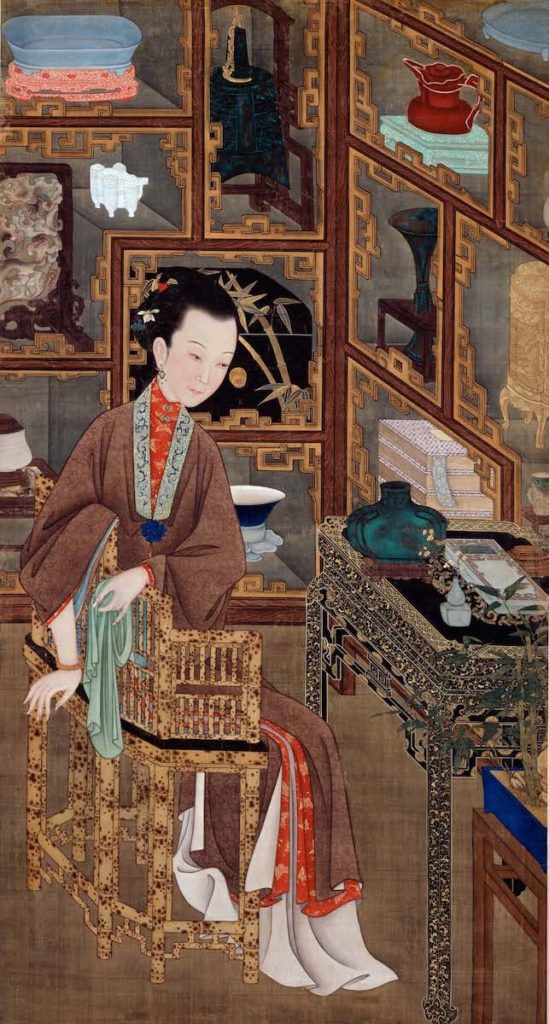
Depictions of niches and spatial renderings in Chinese duobaoge as well as curtain motifs in Qing court paintings provide an important bridge between early modern European still-life paintings and Chosŏn Ch’aekkŏri. As noted by Kim, many Qing Chinese figure paintings such as the Twelve Beauties at Leisure screen commissioned for the Yongzheng Emperor (r. 1722-1735) include depictions of duobaoge and objects for display as backdrops and as part of a narrative scene.[16] Placed in the Yongzheng Emperor’s Deep Inside Weeping Willows Reading Hall (Shenliu tushu tang, 深柳读书堂), a study within his private quarters at the Summer Palace presented to him by his father, Emperor Kangxi (r. 1662-1722), in 1709, one of the panels portrays a lady adorned with layers of whisper-thin garments sitting by a writing desk, marked by an ink stone, engulfed in thought (Fig. 4). Surrounding the woman is a comprehensive collection of brilliant objects, ranging from bronze antique vessels to books wrapped in brocaded covers, all carefully and proudly kept in the compartmentalized furniture. The beautiful figure seated in the bamboo chair is absorbed in her private thoughts—“thinking with,” as Jonathan Hay would say, the objects that surround her.[17] As the beauty gently yet surely holds the silken fabric, her gaze goes astray—neither quite looking at something nor paying attention to the splendid antiquities in the duobaoge. And yet, the ever-so-soft fabric between her fingers seems to fuel her leisurely contemplation and appreciation of the material presence in the room.
The blackness of the lady’s hair spills into the lacquer box of similar color and smooth texture on the cabinet shelf, making it difficult to determine the boundary between the woman’s body and the object upon first glance. This trompe-l’oeil effect is heightened by the woman’s hairpieces doubling as a possible decoration—a flower—on the lustrous lacquer box. Hay notes that lacquer “took on connotations of bodily beauty and tactility,”[18] as it was a staple literary routine in Ming-Qing China to compare hair to black lacquer. The size of the box takes over almost the whole compartment’s space and so creates an illusion of appearing like a lacquer panel or a cover/door instead of a recessed niche. This play on surface and depth is registered in the materiality of lacquer itself, as black lacquer “possesses a smooth surface with a restrained gloss that gives the surface a degree of internal depth, an example of the capacity of materials ‘to delay and materialize the passage of light.’”[19] The mental exercise of introspection and sensorial experience oscillate in the depths and surfaces of material objects in the sitter’s studio. Scenes like this resonate with Korean artists’ and patrons’ similar concerns with the effects of luxury goods on their beholders and users.
“The Jesuit Perspective” and Lee Ki-ji on “The Principle of Things”
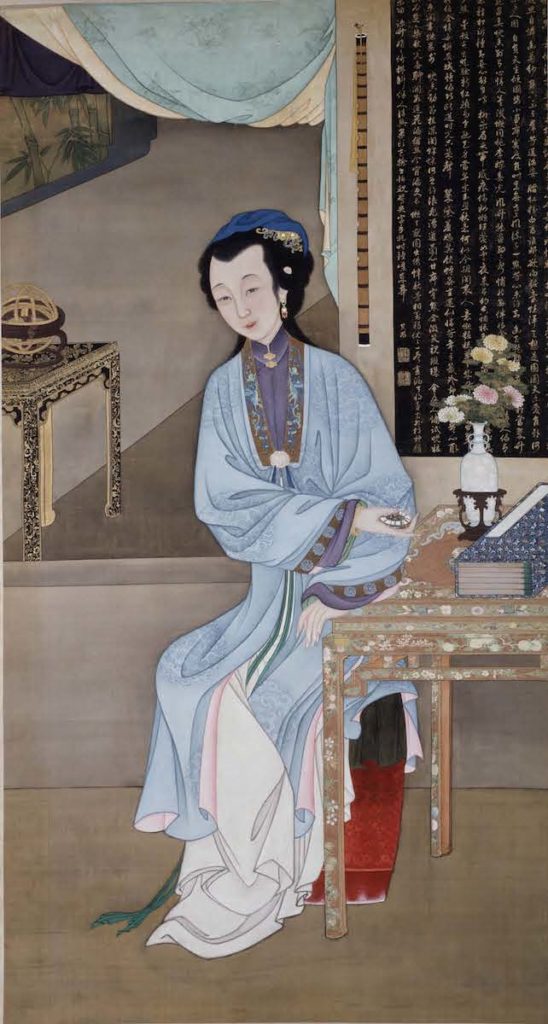
In another panel from the aforementioned screen for the Yongzheng Emperor (Fig. 5), a woman in a study holds a small enamel watch and sits by a table with chrysanthemums and a pile of books. The study is connected to another room through a window with a drawn curtain. The lifted curtain and the use of perspective allow the artist to suggest additional interior space within the overall composition. The European astrolabe on the black lacquer table in the next room, together with the enamel watch held by the lady, indicate the prevalence of European goods in the Qing court’s collection of fine objects. James Cahill argues that contact with European pictures “opened to Chinese painters a broad range of unfamiliar modes of representation, compositional types, and illusionistic devices on which they could draw as they pleased.”[20] The development of linear perspective in Chinese painting followed a different path from that in European painting, but as Cahill and Kristina Kleutghen suggest, linear perspective at the Qing court was often understood as European or as an expression of “Jesuit perspective.”[21] Using the term “perspectival painting” (xianfahua, 線法畫) interchangeably with “scenic illusion painting” (tongjinghua, 通景畫),[22] Cahill describes this manner of depicting space as:
a new, more complex system of spaces opening back beyond the foreground, spaces into which the viewer’s eye could be drawn—not along receding, ultimately converging lines, as in the Italian perspective system, but through windows and doors, or beyond and between objects to further objects and figures diminished […] The practice in Qing pictorial art of constructing see-through compositions with connected spaces opening into depth, then, must have been based on northern European models, Dutch or Flemish.[23]
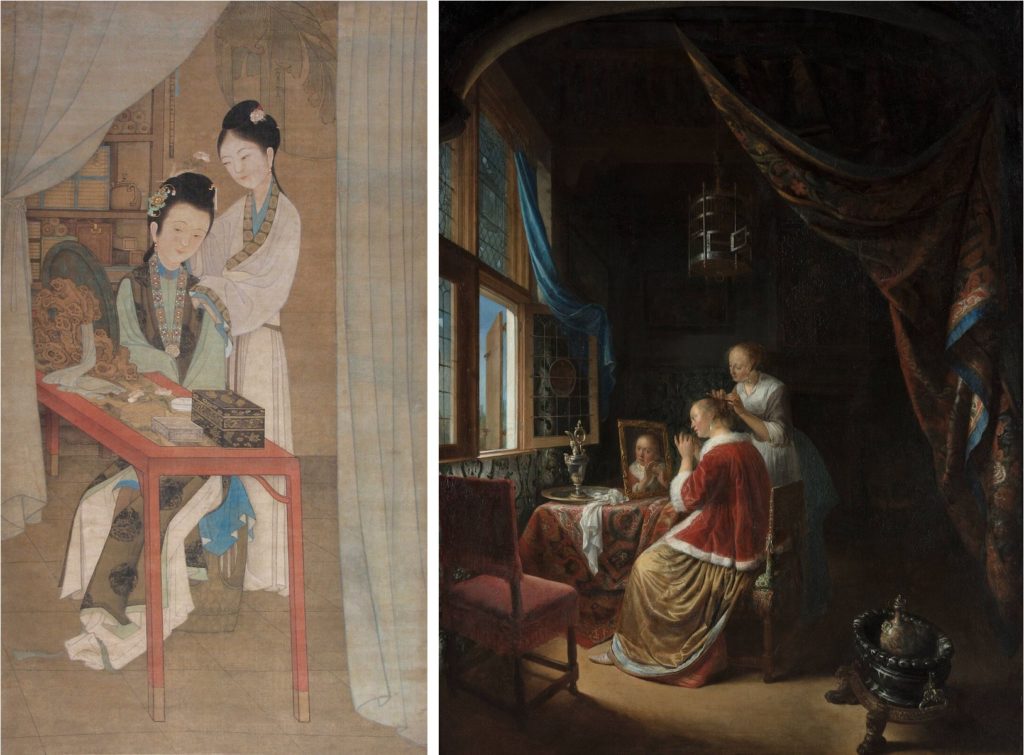
Cahill then compares two paintings of beautiful women in illusionistically depicted private spaces, one by the Chinese painter Leng Mei (ca. 1670-1742 or after) entitled Beautiful Woman at Her Dressing Table with Attendant (Fig. 6), and another by the Dutch artist Gerard Dou entitled Young Woman at Her Dressing Table (Fig. 7), both of which bear obvious similarities to the Twelve Beauties Screen. In both paintings, curtains framing the interior space are pulled back, creating not only depth but also surfaces on which light and dark shades interact. Closed and open cavities, such as windows and bookshelves (including the Ch’aekkŏri-like cabinet behind the curtain in Leng Mei’s painting), “constructing see-through compositions” together with the soft chiaroscuro, propose a play between opacity and transparency.
The Dutch painter Dou produced a number of illusionistic vanitas or bedriegertjes still-life paintings, often with niches and curtains drawn to the sides. Bergström writes that Dou’s best works were installed within miniature cupboards or behind doors upon which Dou had painted further still-life images.[24] Such works recall the “xenia” tradition of painting walls with still-life imagery in Greco-Roman antiquity.[25] As Cahill notes, see-through compositions inspired by Dutch and Flemish works were far more prevalent than the Italian system of vanishing-point perspective in Qing paintings.[26]
Korean travelers to Beijing were especially struck by the trompe-l’oeil paintings inside the Jesuit churches of Beijing and brought European books, world maps, paintings, and engravings back to Korea from their trips.[27] Castiglione was particularly well known among Korean scholars and artists who traveled to Beijing during the eighteenth century. For instance, on his trip to Beijing in 1720, the Korean envoy Lee Ki-ji (李器之, 1690-1722) wrote in his travelogue Iramyŏn’gi (一庵燕記) that he wished to acquire a work by Castiglione, whose still-life paintings were renowned for life-like mimetic qualities. He did succeed in acquiring a painting by Castiglione in the end, although it was not a still life, but a painting of a dog. It was delivered to Lee by another Jesuit missionary in Beijing, Xavier Ehrenbert Fridelli (1673-1743).[28] On rather thick paper, or possibly a panel, Castiglione cut out the painting to follow the contours of the dog painted on it. Lee put it on the ground, letting it lean against a wall, and people passing by Lee’s quarter could not stop commenting on how they had to pause and give the dog a second look before realizing that it was actually a painting. Excited, Lee then invited a monk and his dog from a nearby Buddhist temple. Immediately after spotting Castiglione’s dog, the monk’s clueless dog approached the painting without hesitation, swinging its tail mightily and sniffing at his new friend. Frightened that the dog might ruin the painting, Lee quickly scared the monk’s dog away.[29]
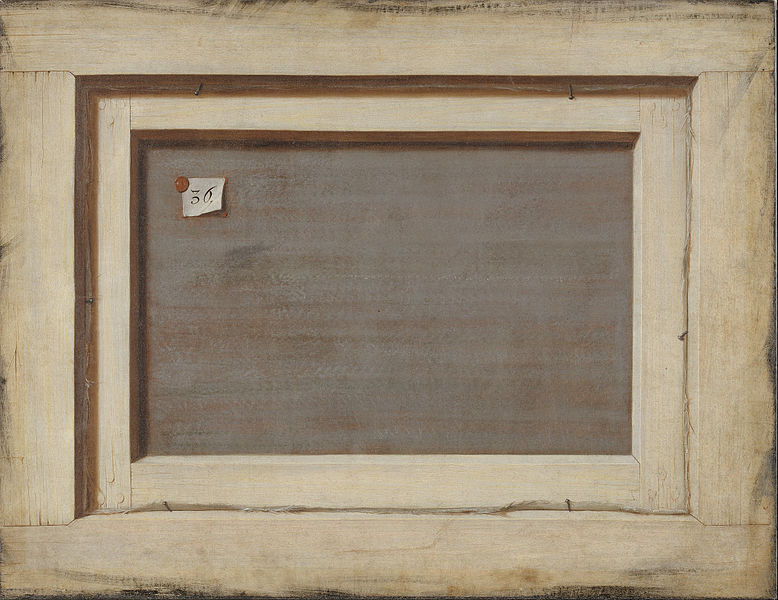
For someone who wished to obtain a vigorously life-like painting by Castiglione, a cut-out dog was perfect. It is difficult to know whether Lee was familiar with Pliny’s Natural History and its story of Zeuxis and Parrhasios. However, Lee’s conscious act of putting this portable cut-out dog in a visible space to fool people’s eyes and to later test this half-truth on an animal is still noteworthy. For Castiglione’s part, it is also difficult to trace whether he was aware of the similar cut-out technique employed by the Flemish painter Cornelis Norbertus Gijsbrechts (ca. 1610- after 1675), who was known for his trompe-l’oeil still-lifes. Gijsbrechts’s famous c.1670 work, The Reverse of a Framed Painting (Fig. 8), now at the Statens Museum for Kunst in Copenhagen, presents a paradox of representation. The painted canvas must be taken for an actuality, as though it were an object that one would have to turn around in order to see the “painting” at the front; and yet it simultaneously denies itself as such with its bravura display of painterly skills. Stoichita aptly remarks that “the object of this painting is the painting as an object.”[30] As an object, it occupies a space and has the potential to be handled, inviting the viewer to wonder what the other side of this wooden frame contains. As the viewer realizes the true nature of the work, it quickly switches back to a painted surface, a comment on representation, or an invitation for the viewer to puzzle out where the limits between actuality and representation lie. Such a Chantourné (uitgesneden or schilderijn in Dutch sources)[31] or cut-out trompe-l’oeil was not intended to hang but to “lean against a wall,” inviting the viewer to pick it up as an object occupying a space,[32] just like Castiglione’s dog. Whether Castiglione and Lee were cognizant of this tradition or not, the artist and his admirer gained maximum satisfaction from experimenting with visual perception, both human and animal.
Lee also recorded seeing various optical devices and scientific instruments, a copy of an illustrated book on natural history, engravings, and Western-style paintings during his stay in Beijing.[33] Lee saw the “heavenly crafts” (Ch’ŏn’gong天巧) and “the apex of human skills” (In’gongjigŭk 人工之極) in these European works, and commented that the Jesuits had thoroughly mastered “the Principle of Things” (Kunggŭngmulli 窮極物理).[34] Lee visited the Jesuit Church in Beijing in late October of 1720. After remarking on various illusionistic wall and ceiling paintings of angels in clouds, the detailed depictions of plants and animals, and the stained-glass windows inside the church, he spots a door propped open on his way out. He sees a dog peering through the door, looking outside the church. Lee goes closer to the door and realizes that it is actually a trompe-l’oeil painting of a dog and a door ajar. His escort tells Lee that it is a painting by Giuseppe Castiglione.[35] A contemporary Chinese visitor to the same church describes other trompe-l’oeil paintings executed by Castiglione. He writes:
In the church of Nantang there are two paintings in perspective executed by Lang Shih-ning [Castiglione]. They cover the whole of two walls, vertically and horizontally, to the east and west of the parlour. If you are standing at the foot of the west wall, close one eye and look at the completely raised bead curtains. The window to the south-west is ajar. Rays of sunlight are playing on the ceiling. Scroll books closed with ivory needles and jade pins fill the library. There is a magnificent cabinet containing “curios” that sparkle from top to bottom. To the north stands a table. And on the table a vase containing a bouquet of pheasants’ feathers. A brilliant feather fan appears in the setting sun. In the rays of the sun the shadow of the fan, the shadow of the vase, the shadow of the table—all perfectly rendered […] Step forward […] The curtains of the entrance door are motionless; everything is profoundly calm. Seen from afar, the table in the room is in perfect order. You are tempted to enter…You stretch out your hand and suddenly realize that you are facing a wall. […] Before such a lifelike representation as this, how one regrets that they were ignorant of it![36]
One could apply the visitor’s ekphrastic description of the illusionistic cabinet shelf containing still-life objects on the church wall to both Castiglione’s duobaoge and Chosŏn Ch’aekkŏri paintings. Castiglione was not only skilled at rendering illusory depths with perspective (perhaps in the Italian school sense, as Cahill would put it), but also in conveying a sense of materiality and volume to the objects in a dark space with careful chiaroscuro. The presence of the illusionistic curtain in Castiglione’s wall painting to aid the overall trompe-l’oeil effect is also notable. As an avid admirer of Castiglione’s paintings, it is highly improbable that Lee missed this wall painting within the same church where he spotted the image of a peering dog.[37] Lee’s encounter with trompe-l’oeil paintings and other Korean travelers’ accounts tell us that they were most curious about and receptive to European arts and sciences that concerned vision and spatiotemporal perceptions, as well as the materiality of objects that seemed “other-worldly” (byulsegae 別世界) to them.[38] Painting techniques that heightened mimetic realism and display quality with the use of perspective and shadows as exemplified in Castiglione’s duobaoge painting must have struck Korean artists and viewers with a particular interest, serving as an inspiration for their own still-life Ch’aekkŏri.
Conclusion
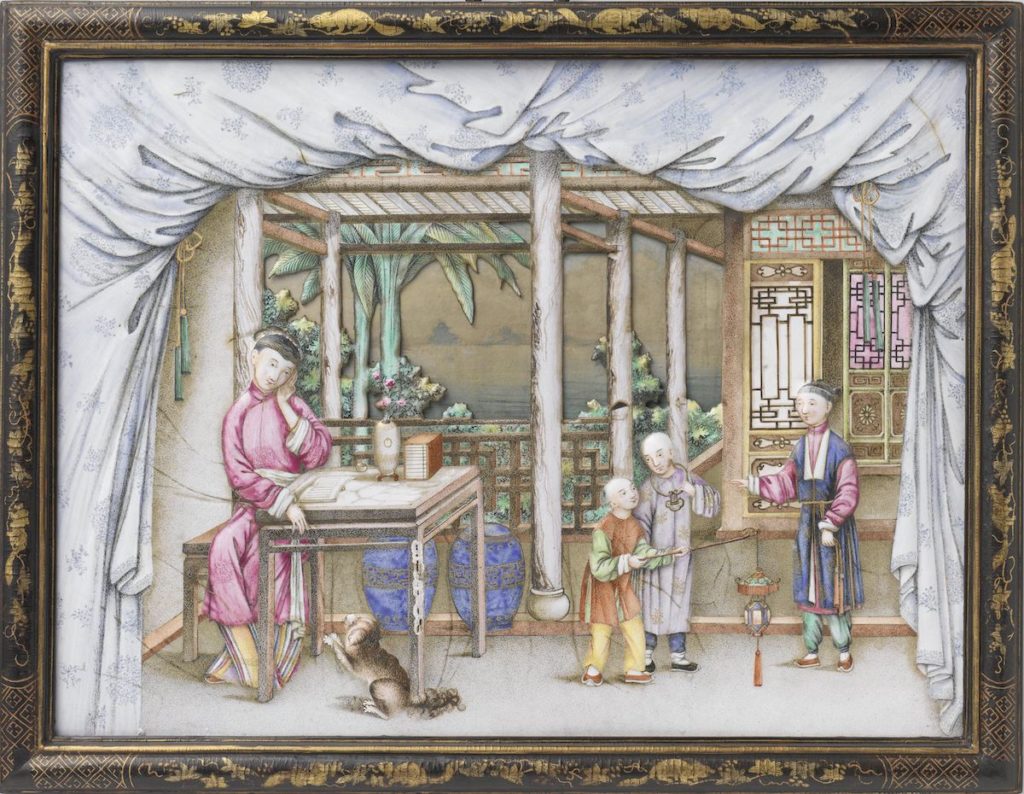
In her article “Eur Asian Layers: Netherlandish Surfaces and Early Modern Chinese Artefacts,” Anna Grasskamp provides a study of eighteenth-century Chinese copper plaques painted with enamel from the Guangzhou workshop, now in the Rijksmuseum collection. A series of four painted plaques feature drawn curtains either framing the whole scene to evoke three-dimensionality (Fig. 9) or included in scenes depicting private, interior spaces. The heavy, shiny, sculpted curtain, which is at once in and on the painting, combines the painted background of oil on paper and the foreground figures rendered in enameled relief, playing with depth and surface as well as materiality and perspective. In another example in the series (Fig. 10), the curtain is placed in front of a bookshelf or duobaoge, in a manner similar to Jang’s example, so that the objects placed on the furniture are unveiled and veiled at the same time. As noted by numerous historians of Qing visual culture and aptly summarized by Michele Matteini, the term “Western” (xiyang, 西洋)—or elements, objects, and influences/inspirations dubbed as “Western”—is a malleable label that exceeds territory and medium in meaning. It referred to “all sorts of things: images, architecture, accessories, fashions made by either foreign or local hands, in a style or technique modeled in some way on recently available imports.”[39] The motif of the transposed curtain in the Guangzhou plaques can definitely be categorized as xiyang or “Western,” and, as Grasskamp argues, as “a Qing dynasty innovation linked to foreign style illusionism and the European idea of a painting as a (curtained) window.”[40] Illusionistic curtains in Ch’aekkŏri paintings emphasize the materiality of the objects depicted, while inviting the viewers to ask—like Zeuxis—what lies behind them. They offer multiple references and insights, enabling me not only to locate the socio-cultural meanings of represented objects in still-life paintings, but also to propose a larger scope of research on the “global eighteenth century”[41] when people, places, and things were constantly in motion.
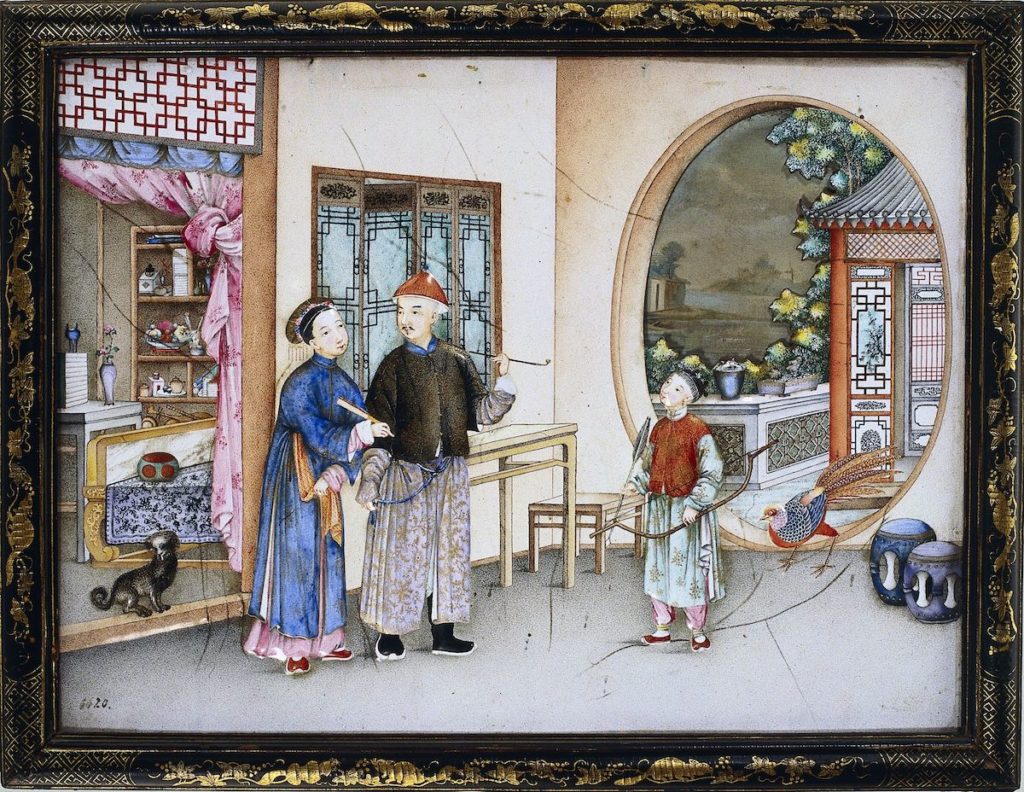
Irene
Choi is a PhD candidate in Art History at the University of British Columbia
[1] See, for example, Burglind Jungmann, “Korean Contacts with Europeans in Beijing, and European Inspiration in Early Modern Korean Art,” in Looking East: Rubens’s Encounter with Asia, ed. Stephanie Schrader (Los Angeles: J. Paul Getty Museum, 2013), 67, 85 (fn 1). In her contribution, Jungmann explains foreign, exotic inspirations in early modern Korean paintings ranging from still lifes to portraits and landscapes. Jungmann discusses what she calls “Baroque” concepts and techniques in Jang Han Jong’s eight-panel Chaekgeori screen with a curtain, and compares Jang’s painting with Rubens’s Portrait of Nicolas Trigault from ca. 1616, stressing only the use of the curtains’ volumes to provide theatrical spatial background. In contrast, I argue that it is more fruitful to explore the resonances of Ch’aekkŏri with early modern European still-life painting instead of portraiture. A recent article by Thijs Weststeijn and Lennert Gesterkamp, “A New Identity for Rubens’s ‘Korean Man’: Chinese Merchant Yppong,” Netherlands Yearbook for History 66:1 (2016), 142-169, proposes another take on the Rubens drawing that Jungmann discusses. Other relevant scholarship on the relationship between Ch’aekkŏri and the idea of the “West” include: Kang Kwanshik, “Yŏngjodae huban ch’aekkado (冊架圖) suyongŭi se kaji p’unggyŏng,” 영조대 후반 책가도(冊架圖) 수용의 세 가지 풍경 [The Reception of Chaekgado: Three Significant Episodes in the Late Yeongjo (r. 1724-1776) Period], Misulsawa shigangmunhwa 22 (2018): 38-91; Han Sehyun, “19segi ch’aekkadoŭi saeroun kyŏnghyang: hop’ijangmaktorŭl chungshimŭro,” 19세기 책가도(冊架圖)의 새로운 경향: <호피장막도(虎皮帳幕圖)>를 중심으로 [A New Current of Chaekgado in the 19th Century: Focusing on a study of ‘Scholars Accoutrements in a Leopard Skin’], Misulsahak 35 (2018), 191-220.
[2] Books covered in opulent silk brocades, like the ones beneath Jang’s shrimp painting at the center of his Ch’aekkŏri, were also reproduced in enameled porcelain during the eighteenth century to imitate the look of stacked books. These famille rose porcelain “books” were empty inside, serving as boxes or containers for further use. This provides another layer to the overall trompe-l’oeil effect in Jang’s painting, here at the level of medium. For one example of these faux porcelain books see Christie’s Hong Kong, The Imperial Sale (30 May 2006), lot 1235.
[3] Paintings of birds/animals and flowers were often pasted over the inside panels of Chosŏn display cabinet doors. See Byungmo Chung and Sunglim Kim, eds., Chaekgeori: The Power and Pleasure of Possessions in Korean Painted Screens (New York: SUNY Press, 2017), 85. This offers an interesting comparison with the Chinese Twelve Beauty Screen panel showing a black lacquer box decorated with its bamboo motif appearing like a painting pasted on the cabinet door.
[4] Victor Stoichita, The Self-Aware Image: An Insight into Early Modern Meta-Painting, trans. Anne-Marie Glasheen (Cambridge: Cambridge University Press, 1997), 258.
[5] Kay E. Black and Edward W. Wagner, “Ch’aekkori Paintings: A Korean Jigsaw Puzzle,” Archives of Asian Art 46 (1993), 65.
[6] Black and Wagner, “Ch’aekkori Paintings,” 65.
[7] Sunglim Kim and Joy Kenseth, “From Europe to Korea: The Marvelous Journey of Collectibles in Painting,” in Chaekgeori, 18-34; Jerome Silbergeld, “From Studiolo to Chaekgeori, A Transcultural Journey: An Introduction to Sunglim Kim’s ‘Chaekgeori: Multi-Dimensional Messages in Late Joseon Korea,’” Archives of Asian Art 64:1 (2014), 1. Although Silbergeld’s comprehensive scope of cabinet forms across Europe and Asia is illuminating, he links Italian studiolo and Korean Ch’aekkŏri by providing a transmission model with a rather uninterrupted genealogy of display cabinet culture from quattrocento Milan to eighteenth-century Joseon Korea. At one point he conflates the Italian studiolo and central-Northern European Kunstkammern and Wunderkammern, suggesting that the studiolo “became” those latter wondrous curiosity cabinets. He writes, “As Europe extended its reach through imperial conquest, in German-speaking central Europe the studiolo became the Wunderkammer (chamber of curiosities) or Wunderkabinett, Kunstkammer (art chamber), and Schatzkammer (treasure chamber) (1).”
[8] Some examples of encyclopedia and manuals from the Ming-Qing period similar to Wen’s Superfluous Things are: Hu Zhengyan (胡正言, 1584–1674)’s Ten Bamboo Studio Manual of Calligraphy and Painting (Shizhuzhai shuhua pu, 十竹齋書畫譜, 1633); Gao Lian (高濂)’s’s encyclopedia, Eight Treatises on the Nurturing of Life (Zunsheng Bajian, 遵生八笺, first published in 1591).
[9] Jonathan Hay, Sensuous Surfaces: The Decorative Object in Early Modern China (Honolulu: University of Hawai‘i Press, 2010), 177.
[10] Chin-Sung Chang, “Ambivalence and Indulgence: The Moral Geography of Collectors in Late Joseon Korea,” in Archaism and Antiquarianism in Korean and Japanese Art (Chicago: The Center for the Art of East Asia, University of Chicago Art Media Resources, 2013), 126.
[11] Burglind Jungmann, Pathways to Korean Culture: Paintings of the Joseon Dynasty, 1392-1910 (London: Reaktion Books, 2014), 270-271.
[12] Wolf Singer, “The Misperception of Reality,” in Sybille Ebert-Schifferer, ed., Deceptions and Illusions: Five Centuries of Trompe L’oeil Painting (Aldershot: Lund Humphries, 2002), 45.
[13] Singer, “The Misperception of Reality,” 46.
[14] The term “haptic gaze” coined by Alois Riegl also has resonance here.
[15] Jean Baudrillard, “The Trompe-L’oeil,” in Norman Bryson, ed., Calligram: Essays in New Art History from France (Cambridge: Cambridge University Press, 1988), 59.
[16] Kim, “Chaekgeori: Multi-Dimensional Messages in Late Joseon Korea,” 6.
[17] Hay, Sensuous Surfaces, 78.
[18] Hay, Sensuous Surfaces, 118.
[19] Hay, Sensuous Surfaces, 118-120.
[20] James Cahill, Pictures for Use and Pleasure: Vernacular Painting in High Qing China (Berkeley: University of California Press, 2010), 69.
[21] “The Study of Vision is generally seen as a demonstration of “Jesuit perspective,” a reflection of Jesuit influence at the Qing court and therefore of the Jesuit mission itself.” Kristina Kleutghen, Imperial Illusions: Crossing Pictorial Boundaries in the Qing Palaces (Seattle: University of Washington Press, 2014), 61. Nian Xiyao’s treatise The Study of Vision (Shixue, 视学, 1735) mentions Giuseppe Castiglione and includes diagrams derived from Andrea Pozzo’s Perspectiva pictorum et architectorum (1707), and Nian specifically credits Castiglione as his teacher “from whom he learned Western painting.” Kleutghen, Imperial Illusions, 60.
[22] Kleutghen, Imperial Illusions, 60. For Chinese studies of vision and linear perspective in relation to European art during the Ming-Qing period, see Kleutghen, “Staging Europe: Theatricality and Painting at the Chinese Imperial Court,” Studies in Eighteenth-Century Culture 42 (2013), 81-102; Hui Zhou, “The Jesuit Theater of Memory in China,” Montreal Architectural Review 2 (March 2015), 37-54; Hui Zhou, A Jesuit Garden in Beijing and Early Modern Chinese Culture (Lafayette, IN: The Purdue University Press, 2011), 96-98; Petra ten-Doesschate Chu and Ning Ding, eds., Qing Encounters: Artistic Exchanges between China and the West (Los Angeles: Getty Research Institute, 2015); Hui Zhou, “Perspective Jing: The Depth of Architectural Representation in a European-Chinese Garden Encounter,” in Alberto Pérez-Gómez and Stephen Parcell, eds., Chora: Intervals in the Philosophy of Architecture 6 (Montreal: McGill-Queen’s University Press, 2011), 275-304.
[23] Cahill, Pictures for Use and Pleasure, 69.
[24] Ingvar Bergström, Dutch Still-Life Painting in the Seventeenth Century [1956] (New York: Hacker Art Books, 1983), 182.
[25] See the chapter entitled “Xenia” in Norman Bryson, Looking at the Overlooked: Four Essays on Still Life Painting (Cambridge, MA: Harvard University Press, 1990), 17-59.
[26] Cahill, Pictures for Use and Pleasure, 83.
[27] These include: Explanation of the Telescope (Yuanjing Shuo 远镜说,1629) by the Jesuit Adam Schall von Bell (1591-1666), and Matteo Ricci’s Chinese translation of Euclid’s Elements (Jiheyuanben 幾何原本) in Ricci’s and Zhizhao’s A Map of the Myriad Countries of the World (Kunyu Wanguo Quantu 坤輿萬國全圖, 1602). See Myeong-Guan Kang, Joseon-ae on Seoyang Mulgeondul (Things from the West to Joseon) (Seoul: Humanist Publishing Co., 2015).
[28] Xavier Ehrenbert Fridelli was an Austrian Jesuit missionary who went to Macau via India in 1705. Later he was summoned by the Qing court in Beijing and participated in producing the Imperial map of China for the Kangxi Emperor (Huangyu quanlan tu, 皇輿全覽圖) until 1718. He also helped make maps relating to China-Korea borders. Until his death, Fridelli had been a rector for Nantang (Southern Church/Wing), the Jesuit Church in Beijing, where Lee saw trompe-l’oeil paintings by Castiglione. See: Lee, Ilamyeongi (Seoul: The Academy of Korean Studies, 2016), 702-703. Upon giving Castiglione’s painting to Lee, Fridelli also pulled out a map and asked about specific details of Korean geography. Lee then helped Fridelli identify a route from China to Korea. See Lee, Ilamyeongi, 385.
[29] Lee, Ilamyeongi, 385.
[30] Stoichita, The Self-Aware Image, 277.
[31] Celeste Brusati, “Honorable Deceptions and Dubious Distinctions,” in Olaf Koester, ed., Illusions: Gijsbrechts – Royal Master of Deception (Copenhagen: Statens Museum for Kunst, 1999), 54.
[32] Sybille Ebert-Schifferer, “Trompe-l’oeil: The Underestimated Trick,” in Deceptions and Illusions, 33. The author further explains that Gijsbrechts’s Back of a Picture is an excerpted detail from an ensemble of Chantourné pieces, Cut-out Trompe-l’oeil with Fruit Piece.
[33] Jongtae Lim, “‘Postponed Reciprocity’: How Did a Korean Traveler Portray His Encounter with Westerners in Early Eighteenth-Century Beijing?” Horizons: Seoul Journal of Humanities 1:2 (2010), 183. For Ki-Ji Lee’s original travelogue entries on receiving or looking at world maps, natural history books, European portraits and astronomical instruments, see Ki-Ji Lee, Ilamyeongi, 219-222 (Book 2, September 22, 1720 entry); 319 (Book 3, October 10, 1720 entry); 378 (Book 4, October 20, 1720 entry); 380 (Book 4, October 21, 1720 entry); and 384-385 (Book 4, October 22, 1720 entry).
[34] Lee, Ilamyeongi, 421 (Book 4, October 28, 1720 entry).
[35] Lee, Ilamyeongi, 409-410 (Book 4, October 26, 1720 entry).
[36] Cecile and Michel Beaurdeley, Giuseppe Castiglione: A Jesuit Painter at the Court of the Chinese Emperor (Rutland, VT: Charles E. Tuttle Company, 1971), 93–94. For the original Chinese text, see: Mikinosuke Ishida, ‘‘A Biographical Study of Giuseppe Castiglione,’’ Memoirs of the Toyo Bunko 19 (1960), 79-121.
[37] Lee wrote his request to meet Castiglione multiple times in Ilamyeongi. See: Ilamyeongi, 337-338; 362; 376; 479; 484.
[38] Lee, Ilamyeongi, 418 (Book 4, October 28, 1720 entry).
[39] Michele Matteini, “The Market for ‘Western’ Paintings in Eighteenth-Century East Asia: A View from the Liulichang Market in Beijing,” in Stacey Sloboda and Michael Elia Yonan, eds., Eighteenth-Century Art Worlds: Global and Local Geographies of Art (New York: Bloomsbury Publishing Inc., 2019), 38.
[40] Anna Grasskamp, “Eur Asian Layers: Netherlandish Surfaces and Early Modern Chinese Artefacts,” The Rijksmuseum Bulletin 63:4 (2015), 376.
[41] This is the name of the HECAA (Historians of the Eighteenth-Century Art and Architecture) panel held in 2018 in which I originally presented this material.
Cite this article as: Irene Choi, “Tactile Vision in Eighteenth-Century Korean Still-Life, or Ch’aekkŏri,” Journal18 Issue 9 Field Notes (Spring 2020), https://www.journal18.org/4868.
Licence: CC BY-NC
Journal18 is published under a Creative Commons CC BY-NC International 4.0 license. Use of any content published in Journal18 must be for non-commercial purposes and appropriate credit must be given to the author of the content. Details for appropriate citation appear above.
